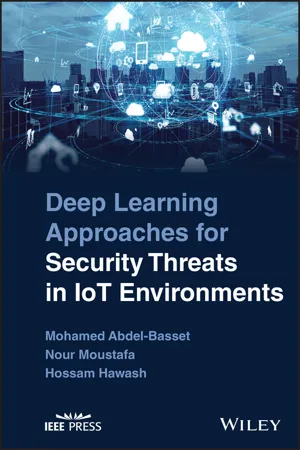
Deep Learning Approaches for Security Threats in IoT Environments
Mohamed Abdel-Basset,Nour Moustafa,Hossam Hawash
- English
- PDF
- Available on iOS & Android
Deep Learning Approaches for Security Threats in IoT Environments
Mohamed Abdel-Basset,Nour Moustafa,Hossam Hawash
About This Book
Deep Learning Approaches for Security Threats in IoT Environments
An expert discussion of the application of deep learning methods in the IoT security environment
In Deep Learning Approaches for Security Threats in IoT Environments, a team of distinguished cybersecurity educators deliver an insightful and robust exploration of how to approach and measure the security of Internet-of-Things (IoT) systems and networks. In this book, readers will examine critical concepts in artificial intelligence (AI) and IoT, and apply effective strategies to help secure and protect IoT networks. The authors discuss supervised, semi-supervised, and unsupervised deep learning techniques, as well as reinforcement and federated learning methods for privacy preservation.
This book applies deep learning approaches to IoT networks and solves the security problems that professionals frequently encounter when working in the field of IoT, as well as providing ways in which smart devices can solve cybersecurity issues.
Readers will also get access to a companion website with PowerPoint presentations, links to supporting videos, and additional resources. They'll also find:
- A thorough introduction to artificial intelligence and the Internet of Things, including key concepts like deep learning, security, and privacy
- Comprehensive discussions of the architectures, protocols, and standards that form the foundation of deep learning for securing modern IoT systems and networks
- In-depth examinations of the architectural design of cloud, fog, and edge computing networks
- Fulsome presentations of the security requirements, threats, and countermeasures relevant to IoT networks
Perfect for professionals working in the AI, cybersecurity, and IoT industries, Deep Learning Approaches for Security Threats in IoT Environments will also earn a place in the libraries of undergraduate and graduate students studying deep learning, cybersecurity, privacy preservation, and the security of IoT networks.
Frequently asked questions
Information
Table of contents
- Cover
- Title Page
- Copyright Page
- Contents
- About the Authors
- Chapter 1 Introducing Deep Learning for IoT Security
- Chapter 2 Deep Neural Networks
- Chapter 3 Training Deep Neural Networks
- Chapter 4 Evaluating Deep Neural Networks
- Chapter 5 Convolutional Neural Networks
- Chapter 6 Dive Into Convolutional Neural Networks
- Chapter 7 Advanced Convolutional Neural Network
- Chapter 8 Introducing Recurrent Neural Networks
- Chapter 9 Dive Into Recurrent Neural Networks
- Chapter 10 Attention Neural Networks
- Chapter 11 Autoencoder Networks
- Chapter 12 Generative Adversarial Networks (GANs)
- Chapter 13 Dive Into Generative Adversarial Networks
- Chapter 14 Disentangled Representation GANs
- Chapter 15 Introducing Federated Learning for Internet of Things (IoT)
- Chapter 16 Privacy-Preserved Federated Learning
- Index
- EULA